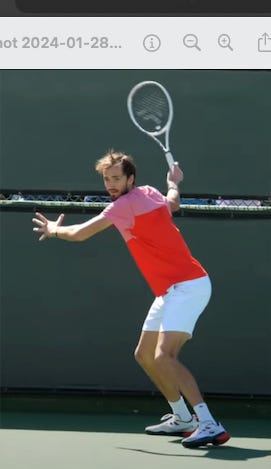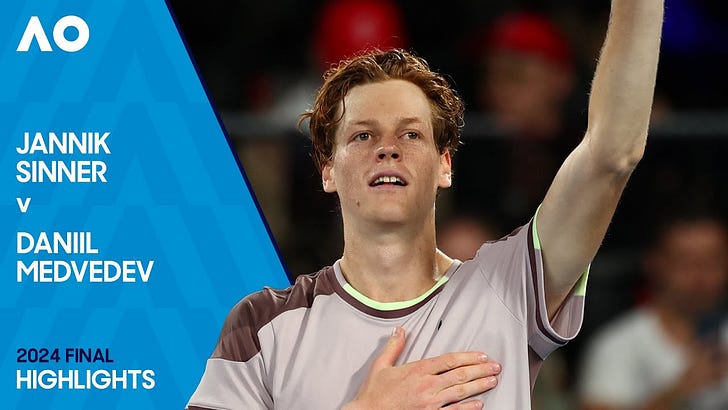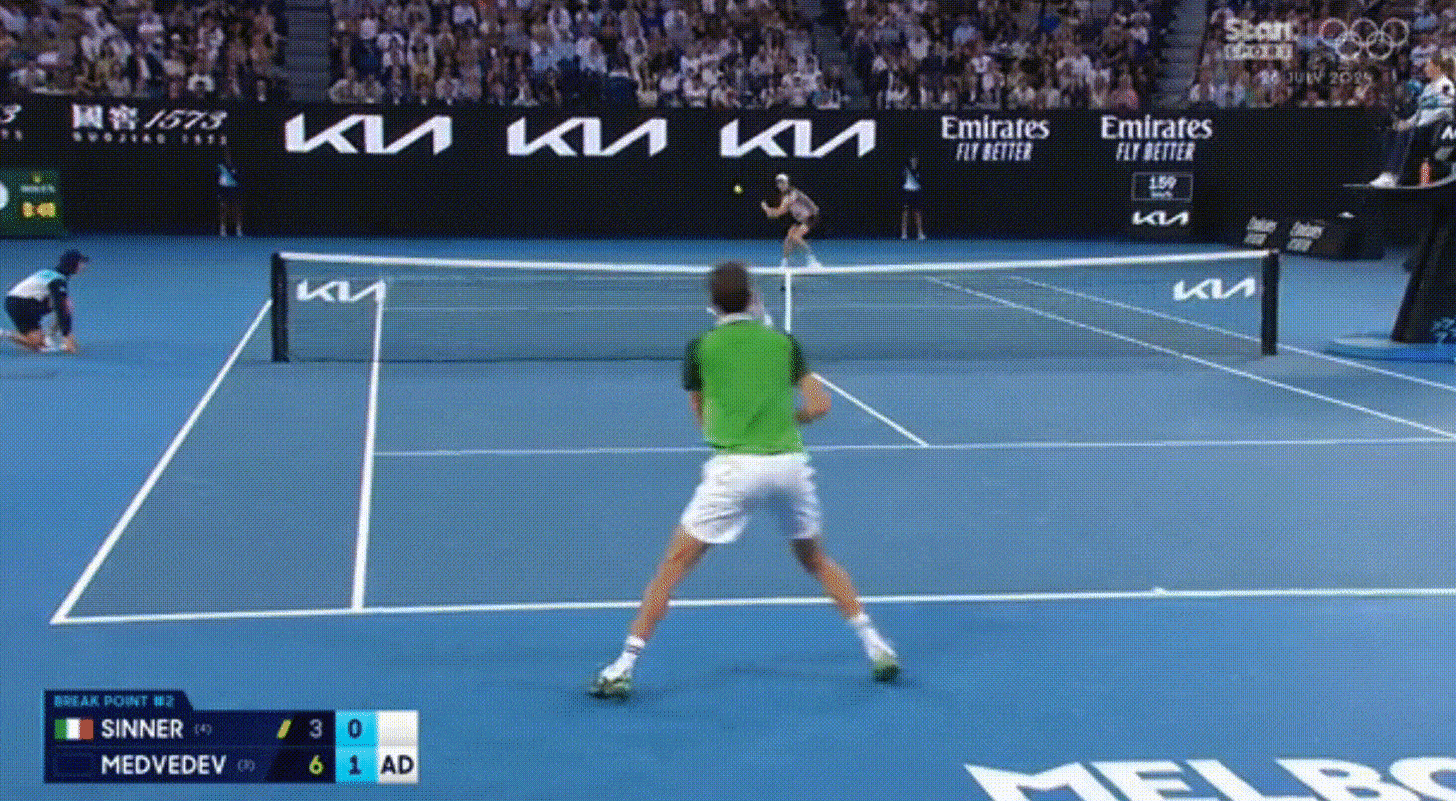Sinner vs Medvedev: AO Final Recap
unconscious aggression — grip changes — off backhands — return positions
Jannik Sinner stormed back from two sets down to defeat Daniil Medvedev 3/6 3/6 6/4 6/4 6/3 in the final of the Australian Open on Sunday, clinching his maiden grand slam title. The 22-year-old Italian has now won 10 of his last 11 matches against Top-5 opposition.1
Before the match I tweeted that Medvedev would employ his usual baseline constriction tactic, playing patiently through the middle backhand channel and going hard into the Sinner forehand when pushed crosscourt. He did that, yet he surprised most — Sinner included — with a degree of aggression rarely witnessed from the Russian. Medvedev outlined the reasoning in his post-match press conference:
“If I was 100% fresh physically, maybe with my coach we could have decided before the match, ‘I’m going to get into these rallies and let’s see who is stronger physically’, but I knew today that I was not in this shape. So I needed to make the points as short as possible, take his time, and it was working well.”
That’s a Rune-esque crush-and-rush early on. Approaching flat middle gives Sinner no angle, height, or time to work with on the passing shot; it almost guarantees that Medvedev will get a look at an above-net volley.
Medvedev is one of the flattest hitters on tour. His strokes draw perplexed looks from pundits and analysts alike who marvel at how he makes balls, but I’ve always contended that he has clean biomechanics and — ironically — of all the Nextgen hopefuls, he has been the player who has most closely imitated the likes of a Novak Djokovic forehand in the three-feet that matters: from the completion of the backswing into contact.
It’s Death of a Forehand approved and was rated highly by Tennis Insights in 2023:


Many people talk of a shot having a higher “margin of safety” (height over the net) because it has more spin, but fail to recognise that it has usually come at the expense of a noisier swing; the swing has less margin for error in timing the ball. Medvedev has very little spin on his groundstrokes, but is extremely consistent because his strokes have high margins technically.

If there is a criticism of the Medvedev forehand, it is the lack of dynamism from the forecourt; he struggles to end points compared to the GOATs. This was his undoing in the heartbreaking 2022 Australian Open final loss to Rafael Nadal. Still, he can hit it consistently low and deep, and what he loses in RPMs, he gains in linear speed. The difference was stark early on:
However, Medvedev’s aggressive intent was evident even before a ball was struck. Usually the Russian stands close to the back wall. Against Sinner, he made an effort to stand closer to the baseline.
This was an important adjustment because Sinner, like Djokovic and Alcaraz, had exposed Medvedev’s deep return position with serve-and-volley in their three prior matches at the backend of 2023. Sinner had won all three matches.

It’s often noted that Medvedev struggles to return closer to the baseline because of his long swings, but another reason is the unique grip change he makes between forehand and backhand. Despite his conservative forehand grip, Medvedev ‘flips’ the racquet (thereby using the same side of the strings for forehand and backhand), meaning neither hand can be fixed for the return: as he waits with a forehand grip, the right hand must slide over three bevels instead of one to find its rightful backhand place, and his top hand must slide down the throat.
This move is usually reserved for extreme forehand grips that make their way a short distance (or no distance at all) to extreme backhand grips (Khachanov, Sock, Almagro, and Kohlschreiber employ this in some aspect of their game).
By standing closer to the baseline Medvedev reduced his reaction time and was forced to guess the return grip. If you watch the match again you can see this is the main reason why he often chipped the return: he had the wrong grip.
It’s another quirk of his game. But however unconventional the backhand grip change is, the backhand itself is a beauty. Mark Petchey called it “a slightly weird style” but familiar readers will see the long inside backswing, the deep left elbow breaking the plane of his body, the locked wrist follow-through. Once again, he has all the elements of the great backhands.
Medvedev’s flat penetrating strokes are the perfect foil for Sinner’s more liquid-whipped swings. The low and deep skidding ball into the lanky Sinner forehand was Medvedev’s ideal shot, as Sinner’s forehand has always looked more comfortable when hit above the knee. Perhaps this is another reason the Italian has often struggled in this matchup; the lower bounce exposes his forehand a little more.2 Here is an off-backhand that can’t be hit any better (Sinner gets there though and wins the point; another example of his hugely improved athleticism and defense).
Look how low that thing stays.
“There’s a 1000 RPM difference between Medvedev’s flat forehand and his backhand, and I just wonder whether he is using his backhand more than his forehand to keep that ball low and use the net as a protector and not allow Sinner to be aggressive.”
“Well that’s been the most valuable shot for me tonight: Medvedev’s inside-out backhand.”
— Mark Petchey
In my Djokovic Movement piece I noted of the Serb and his off-backhand:
while the recipe for being an all-time great has trended toward having a “sword” of a forehand and a “shield” of a backhand, Djokovic has bucked the trend a little, making his forehand more “shield-like”, and his backhand more of a sword, and placing himself closer to the middle of the court.
I’ve repeatedly highlighted how Djokovic has exposed players early in slam matches with his off-backhand excellence. Medvedev is in that mold. I mean, he hits a backhand on this? Fedal would cry:
Medvedev takes his backhand from the middle like this a lot. Watch the match again and you’ll notice this 20-odd times.
“That whole set it looked like Medvedev was hitting down on the ball and Sinner was being forced to hit up on the ball, and Sinner looked like he was hitting his groundstrokes without trust.”
Things didn’t change in the second set.
Medvedev continued to own the baseline real estate, courtesy of being freed from the six-inches of real estate between his ears; he was the ragged, counterpunching underdog forced to throw caution to the wind. What a wonderful space to occupy in a grand slam final. All the pressure was on Sinner.
But at 1-1 in the third consciousness returned:
Wally Masur: “Keep an eye out. That was about the safest rally that Medvedev has played thus far. Everything was pretty careful down that central corridor, and that’s not what got him that two set lead.
John Fitzgerald: “What are you saying, he’s got something to lose now, Wally?
Perhaps the temperature cooled enough to stifle Medvedev’s flat ball, or the legs got heavy, either way, Sinner seemed to have a little more time, the shots came cleaner, the balance restored.
The Italian also made a tactical change on return. On second serves he started to drop back, allowing him to take big cuts at the ball and push Medvedev off the baseline. Compare the first set with the third in the below gif. Notice how deep he gets the return when he gives himself time and space to unload.
Sinner earned a similar forehand error on the first point of the 5-4 game (where he finally broke). The second point was also an example of amazing height and depth — almost a clay court point — to earn 0-30. In fact, that whole game Sinner starts to land haymakers off both sides: hard, heavy, high and deep forehands and backhands that have their genesis in his deeper return position.
Every time Sinner started deep on second serve returns, the whole rally dynamic changed. His ball became that pugilistic right-hook that he is famous for. Medvedev looked uncomfortable. Look at the forehand heaviness rating rise in concert with the deep return position (and cooler temperatures):
One of the things that impressed me about Sinner from the very beginning was how often he found his front leg on the forehand. Berdych, Wawrinka, and Federer were similar in this regard. Those guys could all hit a forehand. In recent times it has been Sinner’s open-stance or running forehand that has got him into trouble, but he has seemed to employ a higher, heavier ball to counteract that tendency this tournament. It makes sense given the rpm’s he can generate.
But Medvedev is cerebral when it comes to tennis (or was he just tired? I’ll give him the benefit). If you keep an eye on his first-serve radar in the fourth set you can see he starts to throw in slow first-serves. At 2-3 especially he chucks it in at 170km/h a couple of times, yet he holds to love, able to play the quick, first-strike, baseline-backhand-hugging tennis that made a mess of the baseline-returning Sinner in the opening hour.
Then Medvedev gets to 0-30 on Sinner’s bowl the next game at 3-3. This was a huuuuuge chance.
But he got passive.
If I had a criticism of Medvedev it was that he didn’t take a chance here. He fell back on his counterpunching instincts, callused on the brain from days spent and dollars earned in such a mode.
He even earns a break point at 30-40, but Sinner fires an ace (the kid was clutch all tournament).
It wasn’t enough. Sinner has been on a tear. You win so much you forget how to lose. He found the haymaker forehands and went on to force a fifth set, courtesy of Medvedev getting a little loose and tired when serving at 4-5.
The 30-30 point of the first game in the fifth set is legendary. 39 shots of side-to-side pain after three hours. Keep in mind Medvedev has punched more than 24 hours on the work ticket at this point. Go watch it. I tip my hat to both guys.
Sinner threatened to break in Medvedev’s first service game. The Russian looked heavier now, hitting slower, but still trying to attack and come forward. His serve kept him alive a little longer, but the rally trend was clearly with Sinner, who was starting to lace it down the line cleanly from both wings.
The break finally came at 2-3.
Medvedev got burned coming forward a couple of times: he missed a ‘wolley’ — a shot he hit wonderfully well all night — and got passed once.
By now Sinner’s dominance was obvious to Sinner, the crowd, and Medvedev. It had a knockout feeling about it; gloves down, feet heavy on the acrylic-blue concrete canvas. And although tennis has been compared to boxing at 90 feet, there is no knockout — technical or otherwise. Each man must win on points.
It makes for a unique form of mental torture to the leader.
Medvedev, again to his credit, fought for his holds and forced Sinner to serve it out.
The knockout blow came at 5-3 40-30. Fittingly, Sinner absolutely belted a forehand down the line for a winner. See the moment below.
In the last three grand slams we’ve had only four men feature in the final: Djokovic, Alcaraz, Medvedev, and Sinner. With Sinner’s win, they have now formed a breakaway from the ranking peloton, and deservedly so; each man has displayed a willingness to make changes and adapt at every moment, a mental resilience to weather tough situations, and a technique that can withstand the adversity of deep slam matches.
I do feel for Medvedev. He has the unenviable achievement of being the only man to lose two grand slam finals from two sets up, but this was only brutal because he was brave enough, and then brilliant enough, to change his game and put himself in a winning position.
This result was due to a feature, not a bug.
I think these four will be the only ones earning major silverware this year. Of course, I can’t rule out a certain other Spaniard should he find good health. But beyond that, grand slam tennis often reminds me of Cormac’s words:
“The world is quite ruthless in selecting between the dream and the reality, even where we will not.”
—All the Pretty Horses, Cormac McCarthy

Forza!
See you in the comments. HC
4x Medvedev, 3x Djokovic
Is this another reason Djokovic’s net clearance was so low in their semifinal? Was he looking to keep the ball low and skidding into the Sinner forehand.














One of the things I was pleasantly surprised about, was Jannik going 20 winners + Forced errors and only 8 unforced errors in the 5th set. So far in his career, he has always performed worse than the Tour Average in serve, return and rally metrics in deciding sets. Not yesterday. Biggest match of his career and he delivered.
A quite stunning rise, very reminiscent of Stan Wawrinka in 2013-14.
I would add Zverev to the list of titel winners this year, his tennis has been getting better and better since he came back from his injury. It also looks like his forehand was a bit more modern this tournament and less NextGen.